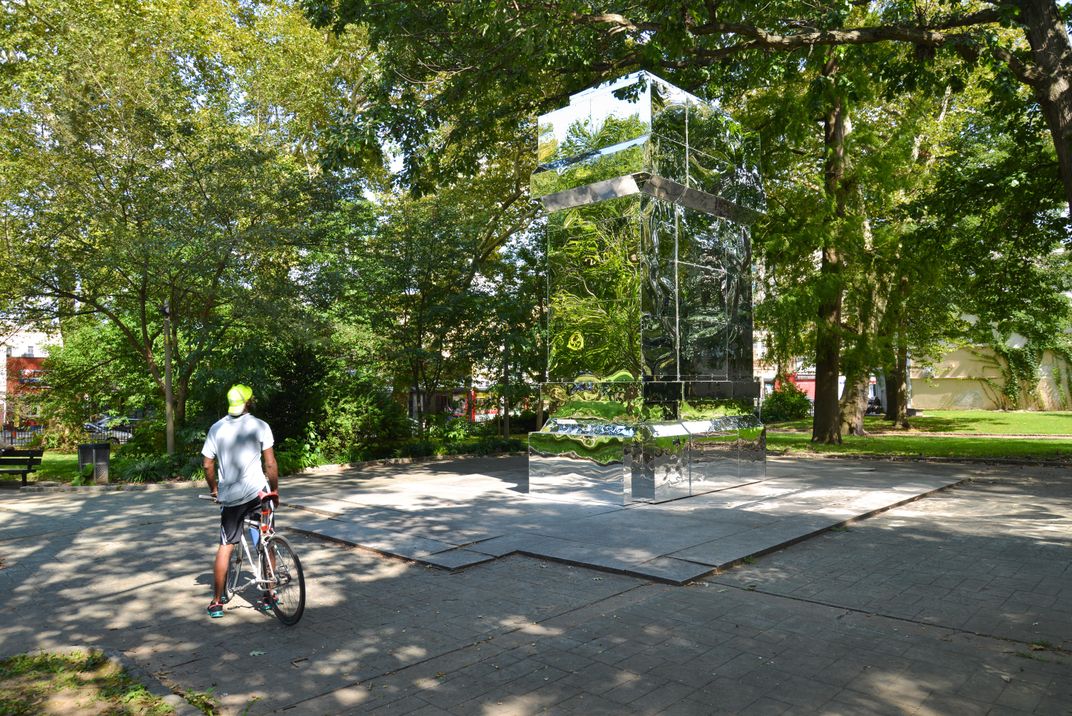Pop-up Monuments Ask What 21st-Century Public Memorials Should Be
A collective of artists adds new, thought-provoking works to Philadelphia’s parks and plazas
At a time when the country is taking a closer look at the monuments that dot our public spaces, and what they signify, a group of 20 artists is asking what public memorials will look like in the future.
Their project is called Monument Lab, and it just launched, spread out over 10 city parks in Philadelphia. The public art and history endeavor is produced by Mural Arts Philadelphia, and each curated piece tackles a new way to think about public monuments, reports Peter Crimmins for NewsWorks, the online presence of WHYY, public radio for the Delaware Valley.
"Monuments are always products of their time. Always reflections of power," Monument Lab artistic director Paul Farber tells Crimmins. Farber also teaches history at Haverford College. "To know that many Confederate monuments went up during Jim Crow and the Civil Rights movement is a reminder of that," he says.
The monuments, on view through November 19, are made using paint, sculpture and photography, as well as sound and performance, even trash and discarded rowhouse stoops, Crimmins reports. Each is accompanied by a lab where visitors can weigh in and offer their own proposals for what a 21st-century monument should be.
On their website, the creators write that they hope their efforts will highlight little-known, obscured or unacknowledged histories in Philadelphia.
The idea behind the Monument Lab has been perculating for some time. The project first grew out of classroom conversations at the University of Pennsylvania, reports Priscilla Frank for HuffPost. An installation in City Hall's courtyard in 2015 followed, supported by the Pew Center for Arts & Heritage.
The monuments that just went up were financed with the help of a Kickstarter campaign that raised more than $50,000.
Artist Sharon Hayes built a temporary monument titled "If They Should Ask," in Rittenhouse Square for the project. The work resembles the bases of statue sculptures already in the city featuring men and their work. Hayes' monument bases will have the names of women who helped shape Philadelphia's history, as an reminder of "the absence of monuments to women in Philadelphia," she tells Huffpost.
Another piece, by artist Karyn Olivier, makes an existing statue disappear. The sculpture Olivier transformed commemorates a battle of the Revolutionary War that Americans lost. By building a box of mirrors around the sculpture, Olivier turns it into something else — a reflection of the surrounding trees. She hopes the change will make people reconsider the statue underneath and their relationship to it. Existing monuments, she tells Newsworks, often outlive the public consciousness that led to their creation.

Artist Hank Willis Thomas' effort is a nearly 800-pound afro pick with its pointing-up handle shaped like a Black Power fist. "This was a period in the late '70s when that kind of afro pick was very popular and in vogue," he tells Newsworks. "It was cool to walk down the street with an afro pick with a black fist in your hair. I didn't quite understand what that meant, and what it was, but it was definitely one of the first objects that was loaded for me." Thomas' installation, which is titled All Power to All People, is located at the Thomas Paine Plaza, within sight of the contentious statue of Frank Rizzo, "the Cop Who Would Be King," a geographic proximity that has already created its own dialogue.
Other installations on view address immigration, opioid addiction, indigenous history and gentrification, reports Nick Vadala for The Philadelphia Inquirer.
While the Monument Lab may be temporary, feedback from the public may result in a permanent new monument in Philadelphia—dreamt up by the people who walk its streets every day.